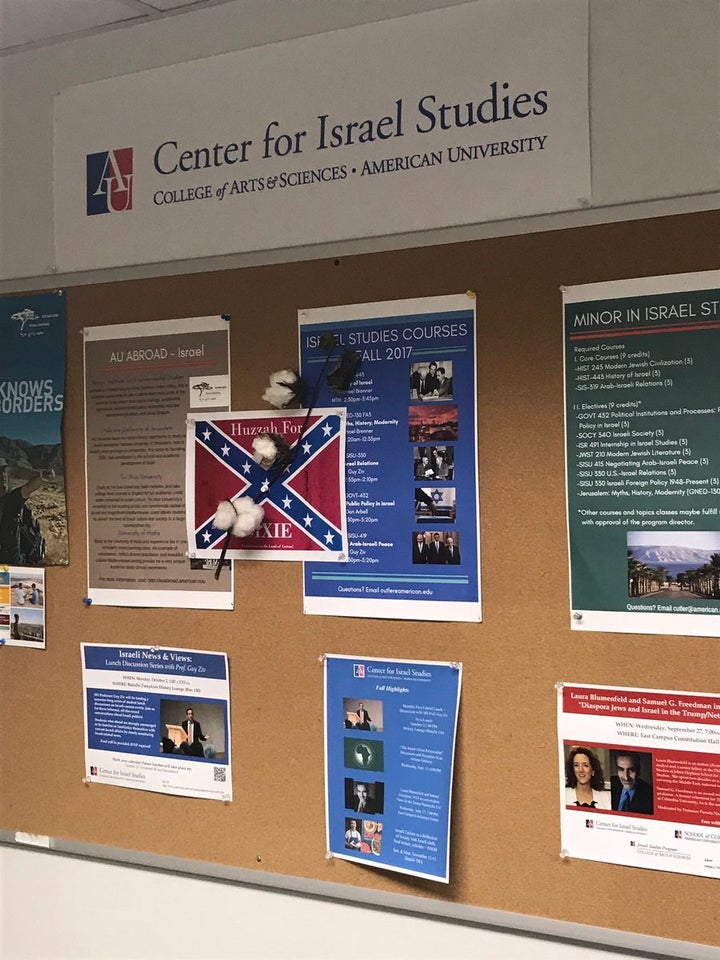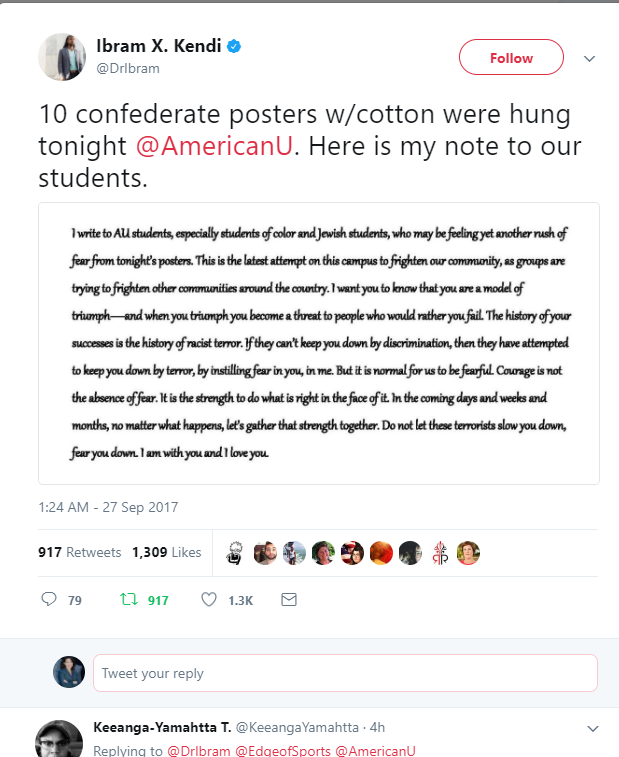
Signs found 9/26 at American University.
On the night of Sept. 26, shortly after historian Ibram Kendi introduced American University’s new Antiracist Research and Policy Center, an as-yet unidentified man hung posters of confederate flags with cotton plants on them in four buildings here.
Video footage and photos show a white man in his 40s, roughly 5’10” and somewhat disguised as a construction worker (as yet, I’ve heard no reports of white men between 30 and 50, 5’5”- 6’3″ being detained because they “meet the description”).
(Kendi, who won the National Book Award for Stamped from the beginning: The Definitive History of Racist Ideas in America noted that he was unsure whether the incident was related to the new center)
As a professor at American University, particularly as one who focuses mostly on teaching first-year students, I find myself once again considering that it’s possible to be heartbroken without being surprised. For the second time in six months, our campus has been the stage for a very public demonstration of white supremacy. I’m heartbroken because my first-year students left home for the first time barely one month ago, and are dealing with this violation as they prepare to write their first college papers and take their first exams. I’m not surprised because in America in 2017, white supremacists have become more brazen and public.
Because this isn’t my first rodeo (see my writing about the last major racial incident at AU), I can already predict some of the pushback our community will receive as we seek ways to embrace and support our students, condemn this hateful act and live up to our mission as an institution of higher education. We’ll be told that college students are weak snowflakes screaming out for safe spaces; that the real story is intolerant liberal students shout down opposing voices. Finally, we’ll be told, in defiance of history and logic, that the Confederate flag is not a symbol of white supremacy, and that our community’s reaction demonstrates intolerance for a form of American heritage.
At the risk of sounding like the ivory tower hyper-educated liberal elite that I am, that is simply bullshit.
And as an educator, I want to take this opportunity to have a real, honest conversation about why.
In my first-year multidisciplinary government class, I assign my students an exchange of letters between a law professor and her students, who had objected to her wearing a Black Lives Matter t-shirt in class. The students had told the professor, among other things, that her wearing the t-shirt violated her obligation to teach law rather than politics; that Black Lives Matter is a movement that promotes violence and marginalizes white people. I generally assign the letters not as a discussion about Black Lives Matter, though I’m transparent about my support for that movement. I do it as a way of discussing our responsibilities in the learning community. Can an 18-year-old who left home a few weeks ago be expected to stand up to a teacher with whom she disagrees? Does a professor have an obligation to pretend to have no opinions?
It’s a fantastic exercise that always yields one of the best conversations of the semester. And it feels particularly relevant as I and my colleagues go back into the classrooms in a context where the pretense of neutrality would be a slap in the face to our students of color.
The law professor’s response to her students has additional value at the moment because she addresses the Confederate flag in it. She explains that whatever the students believe Black Lives Matter means, they don’t have the power to make it mean something it doesn’t.
“There can be reasonable differences of opinion about what something means. Something can even carry a meaning ascribed to it by a particular person. For example, the flag of the Confederacy carries the meaning of white supremacy, even if a particular person thinks it only means “tradition.” One person, or even a group of people, cannot take away the flag’s odious meaning just by declaring that it means something else.”
And here is the crux of why the predictable narratives about liberal snowflakes and safe spaces are unmitigated bullshit:
First, you can’t make the Confederate flag something it’s not. It’s existed to preserve slavery. The addition of cotton plants hammers the point home.
Second, You can’t make a college education mean something it doesn’t, nor make the students, particularly students of color, experience college differently than they do. Those who believe that today’s students are weak and spoiled have no idea what these students go through.
Most adults and non-students have “safe spaces” in the form of our homes. In fact, thanks to civil rights laws and business practices, most of our workplaces are free from the kind of acts and speech to which college students are exposed every day.
College students, by contrast, have to live in close quarters, often with a roommate whom they’re not sure they can trust. My students at the School of Public Affairs of necessity engage in important political conversations about matters like criminal justice, access to voting, and the current administration’s approach to civil rights. And they’re graded on it—often including class participation, which means holding themselves together even when their communities or very humanity is under a microscope. When they’re the only person in the room who looks like them (most white people are in a white bubble of our own creation).
For the second semester in a row, students of color at American University are facing bald-faced attacks on their humanity. Last year, it was nooses with the letters of a black sorority on them ― a reference to domestic terror we call lynching. This year, it’s slavery. It’s a statement that a black person is a commodity; that her spouse could be sold, that his child could be sold. That she is not a part of our body politic; that he is a body, yet not a person.
And then they have to take exams, by the way.
This is reality. Whatever one might want to say, the fact is that our students of color are being forced to show a resilience that few of us could show.
Just as you can’t make these students’ experiences into something they’re not, you can’t make college into something it’s not. College is not specifically designed as a place to learn to be resilient in the face of incivility. Parents don’t scrimp and save and dream so their kids will have an opportunity to go away from home and shoulder the burden of someone else’s hatred because that’s what it will be like in the real world. If college was about learning to suck it up, buttercup, then more syllabi would focus on taking white men out of their comfort zone. College is not supposed to be about facing nostalgia for your ancestors’ enslavement one month after you left your parents’ home, and a week before your midterms. This is not The Hunger Games.
College is about learning to engage with ideas, not to engage with threats to your humanity. College students want to learn to write (I tell myself that), to become professionals, to function more independently in the world, to learn everything from physics to metaphysics. No one dreams of becoming a punching bag. When you see a diploma hanging on the wall, you don’t think “this person spent four years building a thick skin about racism.” You hope they learned math, critical thinking, a love of poetry, how to fall in love, break up, find free food, find a passion, learn a skill, fall in love again, experience wonder, come to know themselves.
As a professor, I can’t pretend that college is something that it’s not, nor deny my students’ experience: particularly my students of color. I can’t pretend that 2017 is something it’s not, either. Someone came to the American University campus to send a specific message to specific students: there are people who want you to feel like nothing more than a commodity. Less than safe. Less than human. Living through something like that is not what college is about. And it shouldn’t be what America is about, either. As professors, parents, and Americans, we need to be honest about that.
*******
Here is Kendi’s powerful message to our students:

I write to AU students, especially students of color and Jewish students, who may be feeling yet another rush of fear from tonight’s posters. This is the latest attempt on this campus to frighten other communities around the country. I want you to know that you are a model of triumph—and when you triumph you become a threat to people who would rather you fail. The history of your successes is a history of racist terror. If they can’t keep you down by discrimination, then they have attempted to keep you down by terror, by instilling fear in you, in me. But it is normal for us to be fearful. Courage is not the absence of fear. It is the strength to do what is right in the face of it. In the coming days and weeks and months, no matter what happens, let’s gather that strength together. Do not let these terrorists slow you down, fear you down. I am with you and I love you.
